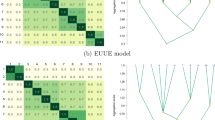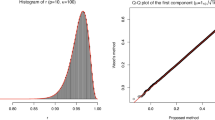Abstract
We develop a method for generating pseudorandom sequences with Gaussian distribution. The method is based on completely uniformly distributed sequences and linear transformations, such as the Fourier transform and Walsh transform. We obtain some discrepancy estimates and make a numerical comparison of these two transformations. Furthermore, we show how this method can be used for testing randomness. We remark that similar approaches are due to Gut, Egorov and Il’in [7], Yuen [26] and Rader [21].
Similar content being viewed by others
References
Ahrens, J. H., Dieter, U.: An alias method for sampling from the normal distribution. Computing42, 159–170 (1989).
Box, G. E. P., Muller, M. E.: A note on the generation of random deviates. Annals Math. Statist.29, 610–611 (1958).
Devroye, L.: Non-uniform random variate generation. Berlin Heidelberg New York Tokyo: Springer, 1986.
Drmota, M., Tichy, R. F.: C-Uniform distribution on compact metric spaces. J. Math. Anal. Appl.123, 284–292 (1988).
Drmota, M., Tichy, R. F., Winkler, R.: Number-theoretic analysis, pp. 43–57. Berlin Heidelberg New York Tokyo: Springer, 1990.
Goldstern, M.: Eine Klasse vollständig gleichverteiler Folgen. In: Zahlentheorische Analysis II. Berlin Heidelberg New York Tokyo: Springer, 1987.
Gut, R. E., Egorov, V. V., Il’in, V. N.: A method of generating normal pseudorandom numbers. USSR Comput. Math. Phys.26, 192–193 (1986) (Engl. translation).
Halton, J. H.: On the efficiency of certain quasi-random sequences of points in evaluating multidimensional integrals. Numer. Math2, 84–90 (1960).
Herendi, T.: On an optical character recognition method, Vol. 2, pp. 373–380. 2nd Conference On Artificial Intelligence, Budapest, 1991.
Holm, S.: A simple sequentially rejective multiple test procedure. Scand. J. Statistics6, 65–70 (1979).
Knuth, D. E.: The art of computer programming, Vol. 2. Reading: Addison Wesley, 1973.
Kuipers, L., Niederreiter, H.: Uniform distribution of sequences. New York: J. Wiley, 1974.
Lehmann, E. L.: Testing statistical hypothesis. New York: J. Wiley, 1959.
Niederreiter, H.: Random number generation and quasi-Monte Carlo methods. Philadelphia: SIAM, 1992.
Niederreiter, H., Wills, J. M.: Diskrepanz und Distanz von Maßen bezüglich konvexer und Jordanscher Mengen. Math. Z.144, 125–134 (1975).
Oppenheim, A. V., Schafer, R. W.: Digital signal processing. Englewood Cliffs: Prentice-Hall, 1975.
Paley, R. E. A. C.: A remarkable system of orthogonal functions. Proc. Lond. Math. Soc.34, 241–279 (1932).
Paskov, S. H., Traub, J. F.: Faster valuation of financial derivatives. J. Portfolio Management 113–120 (1995).
Petrov, V. V.: Limit theorems of probability theory. In: Oxford Studies in Probability, Vol. 4, pp. 147–149. Oxford: Oxford Science Publications, 1995.
Press, W. H., Teukolsky, S. A., Vetterling, W. T., Flannery, B. P.: Numerical recipes inC. Cambridge: Cambridge University Press, 1992.
Rader, C. M.: A new method of generating Gaussian random variables by computer. Lincoln Lab. Tech. Note49, (1969).
Schipp, F., Wade, W. R., Simon, P.: Walsh series. Bristol New York: Adam Hilger, 1990.
Stadlober, E., Niederl, F., C-Rand: A package for generating nonuniform random variates. Comp. Stat., 63–64 (1994).
Winkler, R.: Some remarks on pseudorandom sequences. Math. Slovaca43, 493–512 (1993).
Yaroslavsky, L. P.: Digital picture processing. Berlin Heidelberg New York Tokyo: Springer, 1985.
Yuen, C. K.: Testing random number generators by Walsh transform. IEEE Trans. Comput.26, 329–333 (1977).
Author information
Authors and Affiliations
Additional information
The authors are supported by the Austrian-Hungarian Scientific Cooperation Programme, Project Nr. 10U3
This author is supported by the Austrian Science Foundation, Project Nr. P10223-PHY
Rights and permissions
About this article
Cite this article
Herendi, T., Siegl, T. & Tichy, R.F. Fast gaussian random number generation using linear transformations. Computing 59, 163–181 (1997). https://doi.org/10.1007/BF02684478
Received:
Revised:
Issue Date:
DOI: https://doi.org/10.1007/BF02684478




